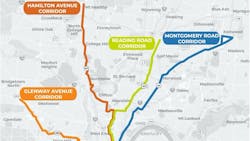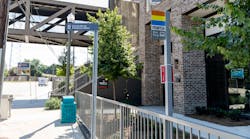Cincinnati Metro launches study to identify corridors for new BRT service
Cincinnati Metro aims to bring bold new transit innovations to Hamilton County and greater Cincinnati through its Reinventing Metro Plan. Among these is Bus Rapid Transit (BRT), which will bring faster service and reduced travel times to the region’s primary travel corridors.
Cincinnati Metro has identified four potential BRT corridors and will start service on two of them as the first step toward building a regional BRT network. To kick off that process, the agency has launched a nine-month study to determine which two corridors will be the first, with multiple opportunities for the public to get involved in the process.
“BRT is a high-quality, bus-based transit option that combines the fast and efficient characteristics of rail transit with the flexibility of traditional bus service,” said Khaled Shammout, chief strategic planning, development and innovation officer, Cincinnati Metro. “It’s fast and comfortable, cost-effective and reliable and will be transformative for those who rely on transit to get to work, school and other activities and opportunities. It can also benefit the communities it serves – not only as a new transportation option but as a catalyst for revitalization and growth.”
Faster travel, stronger communities
BRT systems improve travel times through a variety of means, most directly with frequent service, limited bus stops, smart traffic signals and dedicated bus lanes where possible. Enhanced bus stops/stations offering same-level entry improve accessibility for all riders, while pay-in-advance fare systems reduce wait times when boarding. As with all of Cincinnati Metro’s services, the use of BRT will help reduce local congestion and vehicle emissions, which improves local air quality and reduces noise levels.
Additionally, BRT systems support economic growth by encouraging equitable transit-oriented development around BRT stations and stops.
“Reinventing Metro isn’t just about improving bus service in our region; it’s also about lifting up the communities we serve,” said Cincinnati Metro CEO and General Manager Darryl Haley. “By boosting the level of transit access along these travel corridors, we won’t just reduce travel times. We’ll also transform these communities and drive their growth for decades to come.”
When developing the Reinventing Metro plan, the transit agency identified four of Metro’s most heavily used transit corridors as possible alternatives for introducing BRT. Two will be selected for initial service and other corridors would follow in the future to create a regional network of BRT lines. The corridors are identified by the primary roads they follow, each connecting to downtown Cincinnati: Glenway Avenue, Hamilton Avenue, Reading Road and Montgomery Road.
The BRT study will analyze each of these corridors in terms of its ability to attract riders, improve transit speed and reliability, enhance transportation network connectivity, provide equitable access, support the construction of BRT infrastructure and their potential to support economic development opportunities.
Public input will be an integral part of this process and many input opportunities will be held throughout the study. A series of in-person public meetings has been scheduled over the next few weeks to introduce BRT to the public and gather input on the alternatives being considered.




